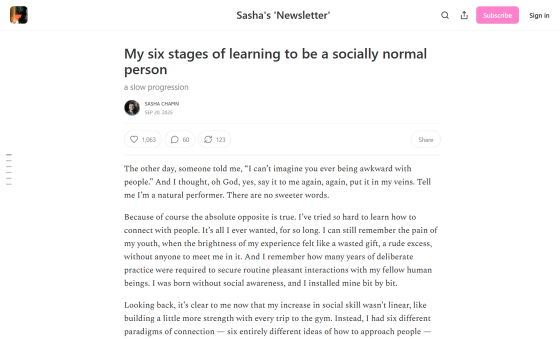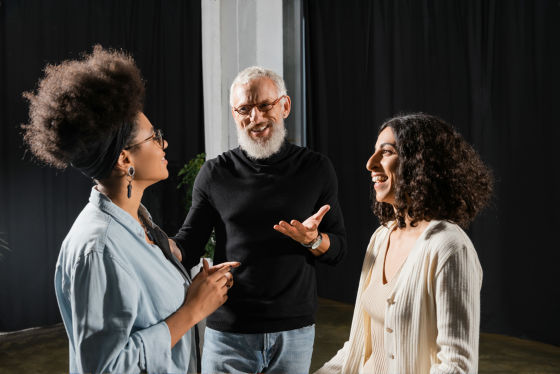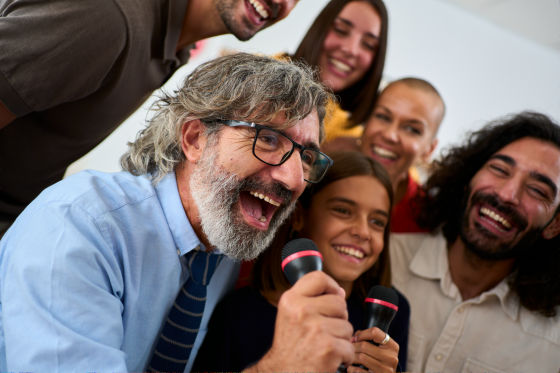What are the '6 realizations' that people with communication problems have experienced before becoming more sociable?

Freelance writer Sasha Chapin is now such a sociable person that she can't imagine being awkward around people, but she used to have a hard time interacting with people. Chapin explains the six realizations she believes were important in achieving normal social skills.
My six stages of learning to be a socially normal person

◆1: Become an attractive person
As a child, Chapin was irritable, blunt, excitable, and sensitive, which led to severe bullying at school. Growing up, that didn't change, but as he became addicted to the radio show 'This American Life,' he realized the adults on the show were witty, sophisticated, confident, and self-deprecating—a completely different kind of person.
Chapin aspired to be a host on The American Life, so he decided to be 'interesting to listen to' and stuck to that attitude throughout college, using his ukulele, reciting poetry, dramatic stories about his life, and opinions on academic topics to attract attention.
This earned Chapin some recognition, but the reviews were mixed, with some saying he appreciated his academic intelligence and others saying he was exhausting. Furthermore, these efforts only served to show off his erudition, and he still couldn't truly become close with people.

◆2: Respond according to the other person's needs
After graduating from college, Chapin began working as a dishwasher at a high-end restaurant, and was eventually considered for promotion to bartender, but his poor social skills were a hindrance. He observed respected waiters, and found that while some played stereotypical roles, such as 'a witty gay man' or 'a cheerful country girl,' truly excellent waiters had the flexibility to 'understand what kind of social interaction the other person wanted and enjoy it together.'
For example, if a customer sat at a table and ordered brusquely, a good waiter would respond efficiently and stoically. If the customer wanted to make a joke or have a lighthearted conversation, the waiter would respond cheerfully and welcome any remarks. In other words, good waiters didn't solidify an existing identity, but simply had a sense of fun and tailored their service to each customer.
After learning this method, Chapin practiced diligently to acquire flexibility. In particular, restaurants were the perfect workplace to try out new methods because customers change regularly. After a year, his boss had praised him, saying, 'You may not be a top salesman, but you make people feel incredibly comfortable.' By this time, Chapin felt that he had become quite an attractive person.

◆3: Ease the other person's tension and become a friendly presence
As Chapin began working at more sophisticated restaurants, he found himself surrounded by far superior waiters who had honed their skills in social situations for over a decade. What captivated him most was a waiter who would forget orders or accidentally offer a menu item that had already been sold out, but who was beloved for his sociable nature.
What was strange about this character was that he had many unique phrases and habits, such as saying 'Let's go home!' as a greeting or saying 'What a cute ball' when praising something. After observing for a while, Chapin realized that these eccentricities were an implicit message to those around him that 'it's okay to relax here,' and that this was the reason why people loved him.
So Chapin himself introduced a bit of harmless quirkiness to his conversations, deliberately asking if customers wanted water by saying, 'Hi... water... can I bring it to you?' Most customers liked the exchange. 'By deliberately being awkward,' Chapin said, 'I made myself a friendly pal, rather than a cold representative of a pretentious establishment.'
On one occasion, he spilled olive oil on someone's clothes and said, 'I'm sorry, I was distracted by how wonderful you are,' which actually made them like him. Even at the time of writing, Chapin still focuses on 'easing the other person's tension' rather than 'telling them something' in most casual conversations.

◆4: Detect the other person's subtle physical signs and let yourself go
Chapin left fine dining to become a freelance writer, and like many in his California-based community, became a self-therapy and meditation enthusiast. He suddenly found himself understanding how his own emotions impacted his subjectivity, and he suddenly began to pick up on the subtle nonverbal cues of those around him.
Among Chapin's new observations were the fatigue of those who feel underestimated, the guardedness and rigidity of anxious leaders, the rapid emotional ups and downs of nervous intellectuals, the languid tone of those who present themselves as potential sexual objects, and the lion-like nonchalance of those with genuine self-confidence.
'I began to see new, nuanced aspects of people I'd known for years. It was like seeing them all again,' Chapin says. 'From this new perspective, human connection felt like a dance. Focusing on the information I was receiving through body language in real time would slow down communication. But simply responding, captivated and immersed in the physical data in front of me, somehow usually worked.'

◆5: Love and accept the other person
Chapin started writing coaching in 2021, but initially had little experience in coaching and was searching for his own style. Meanwhile, Chapin thought of people with 'healing power' who have an open attitude without prejudice, and tried to imitate the ways of these people when coaching.
By simply listening to what his clients had to say, rather than trying to get to the root of their problems, Chapin found that his clients would eventually burst into tears, expressing their gratitude for opening up. In fact, Chapin didn't do anything other than relax, gaze kindly at his clients, and ask a few questions, but he said many people felt saved by it.
Chapin's analysis shows that many people don't have anyone eager to listen to them, and they want to be heard, so simply being present and open and listening can make them feel like an oasis in the desert. Since he learned to use this method intentionally, Chapin has been able to quickly build rapport with anyone, whether it be a patient with schizophrenia or a first date with someone he has little in common with.

◆6: Be selective about your connections
Chapin had developed a strong ability to connect with others, but he eventually began to ask himself, 'Do I really want to connect with others more?' He realized that rushing to maximize emotional connection, even in therapeutic conversations, wasn't always the best approach.
He also said that his current wife, who he started dating around the same time, pointed out to him, 'It seems like a lot of women are in love with you. I don't think it's malicious, but it must be because of something you have,' and he realized that this was true. 'And it was. I was indiscriminately flirting with emotional connections, but I ignored the fact that it could easily be interpreted as 'cheating.''
So Chapin decided to slow down his connections with people and set a goal: 'I want to think of connections as a dial that goes from '0' to '10' and be comfortable on every dial.' Chapin says he's now almost achieved this goal.
'I have some heartbreakingly emotional interactions, but I also have some superficial, light-hearted, bouncy conversations,' Chapin said. 'People say I seem standoffish, sometimes a little intimidating, but I actually welcome that. I guess I'm finally socially normal.'

Related Posts:
in Note, Posted by log1h_ik







